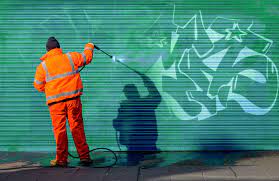How to Remove Graffiti
It all depends on the type of surface, whether it is concrete, wood, metal or concrete. Depending on the type of graffiti you are dealing with, there may be multiple ways to answer the question “How to remove graffiti”. Because each substrate or surface is composed of different components that interact with graffiti in different ways. The most effective way to remove graffiti is different for each surface. Concrete, brick, block, and other concrete ingredients, as well the porosity, surface finish, and porosity can all affect how graffiti bonds with that substrate. This product can be used to remove graffiti from wood, metal, and masonry. Because it does not contain methanol or methylene chloride, this product is safe for use in many areas.
This paint stripper can be used on all hard surfaces. It can also remove clear coats and high-strength paints without using methanol or the methylene chloride. It has a gel consistency, making it spill-resistant and easy for you to use. It works well with oil-based alkyd and acrylic paints, clear sealers spray paints, spray paints as well as marking pens, lacquers yellowed sealers, wax buildup, and lacquers. This product has a major advantage: it doesn’t require surface neutralization and can be rinsed off with hot or cold water.
A solvent is a liquid that dissolves another substance. The right solvent can make your job easier. Choosing the wrong one could cause damage to tools or work projects. It is important to be knowledgeable about the best solvents, their uses, and when they can be used. This will help you avoid making costly mistakes. The more graffiti is left to dry, the stronger and more difficult it will be to clean up.
Most chemical solvents can be flammable and emit toxic fumes. Before using any chemical solvents, make sure you read all instructions and follow all safety precautions. Limit your purchases to the amount you use, and keep them out of reach of pets and children.
Graffiti Removal Techniques
Acetone
Acetone is a popular solvent for plastics. Acetone is effective in removing plastic cement residue, particularly cyanoacrylates (also known as super glues or instant glues). It is recommended for fiberglass and polyester resins. It can melt vinyl plastic.
Lacquer thinner and acetone are good for removing varnish and paint, but they can also soften and dissolve plastics such as Plexiglas. These solvents can damage bristles if you use a nylon brush to apply them. Lacquer thinner and acetone are both highly flammable and can be inhaled.
Alcohol
There are many types of alcohol available: isopropyl methyl, ethyl, wood etyl and denatured. Isopropyl alcohol, also known as rubbing alcohol, is a form of alcohol that can be used externally for medicinal purposes. It can also be used to remove resinous stains as well as removing gummy tar residues such magic markers and shoe polish.
It is used to thin shellac and clean brushes that are used to apply it. It can also be used to erase light pencil marks from wood. You can also use it to clean permanent markers.
Lacquer Thinner
A lacquer thinner is a mixture of two or more solvents. Lacquer thinners often contain acetone, amyl or the ethyl Acetate, ketone, and toluene. Lacquer thinners can be used to thin lacquers or clean equipment that is used in lacquer finishing. Most paints can be softened and dispersed even after they have hardened. It’s highly effective in removing spray paint. It can, however, soften underlying paint as well as many plastics and vinyl.
Methylene Chloride
Methylene chloride is the main ingredient in most paint removal products and heavy-duty brush cleaners. Methylene chloride is sometimes sold in combination with other ingredients to be called “graffiti removal”. It can be used to remove all types of finishes. However, it also softens and attacks plastics. This solvent can cause skin irritation so make sure to wear rubber gloves.
Mineral Spirits and Turpentine
Mineral spirits are also known as “white spirits” and are a petroleum distillate that is specifically made to replace turpentine. It is cheaper, less sticky, and has a milder odor than turpentine. Most painters use it to thin their paint. Although turpentine is able to remove paint that has slightly hardened, mineral spirits and turpentine are both good first-time cleaners. Only fresh paint can be dispersed by mineral spirits.
Naphtha
Naphtha, a petroleum solvent that is similar to mineral spirits, has a higher volatility. It is used primarily as a paint thinner and as a cleaning agent. Naphtha has a stronger solvent than mineral spirits so it can dissolve more paint. Naphtha can be highly explosive. Use it in an area that is well ventilated and use rubber gloves. Use crayons with care.
How can Graffiti be removed from a brick wall?
Graffiti on your wall or at your business can be very frustrating and upsetting. We understand that it can be difficult to remove without the right products and knowledge.
Brick has an uneven surface, which means graffiti paint absorbs into uneven porous brick making it difficult to scrape off or wipe off. Although chemical and gel masonry strippers are effective in removing graffiti from brick walls, it can take time and a lot of application. The chemicals can also pose a risk to your skin, eyes, and respiratory system.
You should soak the paint in an absorbent cloth if it is still damp. Do not wipe it as the paint will spread. After you have removed all the paint with the absorbent cloth, you can use white spirit or another solvent to get rid of the rest. You will need to use degreasing solvents to get rid of the white spirit. It has a strong smell and can leave behind a grease residue. Although this is a time-consuming process, if you hire a specialist to remove Graffiti, it may be possible to use any of the following products. They are water-based and non-toxic, making them safer than other products.
Scrape away as much paint as possible after it has dried. To remove any remaining paint, you would normally use a paint stripper or remover. However, most paint removers and removers contain strong chemical removers that dissolve paint and varnish, but are dangerous. If not used with care, they can cause irritation to the skin and eyes. They can also cause headaches, drowsiness and nausea.
How can you remove Graffiti on metal surfaces?
There are several options available to you when trying to remove graffiti on a metal surface. Here are some of the more popular methods.
You can use WD40, lacquer thinner, or acetone as a paint thinner. You will need to use a degreasing agent to get rid of the grease. You can also rub it with a steel brush, bronze brush, or light sandpaper if this fails. You should be aware that metal can get scratched, dulled, or discolored if you attempt to remove it in this manner. You can also try jet washing it, but this is not a common method of removing the metal.
Last Thoughts
Graffiti is now more popular than ever. It’s vandalism to business owners. Graffiti can be removed quickly to make it easier for vandals to target the area. It can be prevented by using cameras and warning signs.


Comments are closed